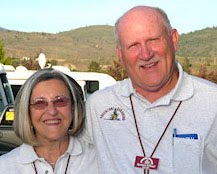Day 29--to Denali National Park(travel day)
Our travel day began as it does quite often--breakfast out. The four amigoes (Marvin, Dee, Sheryl & Bob) went to the local Denny's in Fairbanks. A fact which you all may not know is that this Denny's is the northern most one in the world. They have a sign outside the restaurant.On the way Marvin and Dee saw Denali but we didn't get a view.
We stopped at the little town of Nenana which means "a good place to camp between the rivers" in case you didn't read your Milepost but then somewhere else I read that the Nenana River was named for a Philippine card game. Oh well! During the early 1920's it was the construction base for the Alaska Railroad. Pres. Harding drove the golden spike in 1923 signifying its completion. Today it is the hub for the tug/barge shipping on the rivers of the Interior. Personally I don't know how they do it with the rivers being so shallow and silt-laden going 12mph downstream and 5mph upstream. The lady at the visitors center gave us a good speal for going to see differnt things and we were gullible. While the boys slept Dee and I went exploring. We stopped at all the appropriate gift shops all the way thru town. We walked down to the general store to look at her collection of hand made items and Dee was lusting after a warm winter pull down hat lined with beaver fur and another fur on the outside. It was beautiful. We mosied on down past the "Moocher's Bar" to the Depot and perused their items where I did make a couple of small purchases. Upon leaving we saw the monument to the completion of the railroad.
We stopped in at the small, quaint St. Mark's Episcopal Church. Lots of wood carving at the end of the pews and on the altar plus the altar cloth had a lot of bead work on it. A lovely church.
As we walked down to the Cultural Center by the river we passed the Tripod they use to put out on the ice that is hooked to a line on shore which is then hooked to a clock. When the ice breaks and begins to move downstream it will break the line and the time will be recorded. This breaks the tedium of a long winter, I guess. The Cultural Center had a number of items, pictures, furs and history and a gift shop. They had two books written by Miles Martin, the same guy our bus driver was telling us about on our trip to the Artic Circle. He was saying that his first woman had a few cards short of a full deck. They had a very long boat with little depth to it and they use these type of boats for races like the regattas in the lower 48. I don't know how they keep water out of the boats. Across the river from the Center was a large white cross and upon inquiry found out that it was originally the cemetery for the local native people, but young man there said that now everyone want to buried there. A missionary who served in the area many years ago was buried over there when she died.
While we were all standing around near the road by the Visitor Center the lady who runs the gift shop across the street came over to see if we wanted to see a demo of the Ulu knife. She told us this story. Two of the native boys had decided they were not going on to further schooling after high school and the missionary was very concerned. They went on to tell her that they had a plan and that plan was to produce the Ulu and package it and get the Good Housekeeping Approval stamp and sell them to tourists. She was impressed with their plan. The Ulu's originally were made from old saw blades with bone handles and when they took them to Good Housekeeping they were not impressed and could not endorse them. So the boys took their concerns to heart and made them from stainless steel and the handles from a sealed polished wood and received the stamp of approval. Now you know the rest of the story. These are only made in Anchorage, Alaska.
We passed the sign for the Clear Air Force Station which is a ballistic missile early warning site. Bill Kern did you see that the town of Anderson hosts an annual Bluegrass Festival? We also made a stop at the Tatlanika Trading Post and wandered their gift shop and looked at all their old equipment and stuffed animals--the biggest of which was a huge polar bear that is in the record books. That was our last stop, but I found the change in landscape as we travelled today to be interesting and then to get back into these beautiful peaks.
The evening was topped off with our briefing and a wonderful supper provided by not only the staff but a large potluck by fellow caravaners. I think we can all say that we did not leave hungry.
Thanks to everyone. Another busy day tomorrow. Goodnight Mrs. Calabash, where ever you are.














































